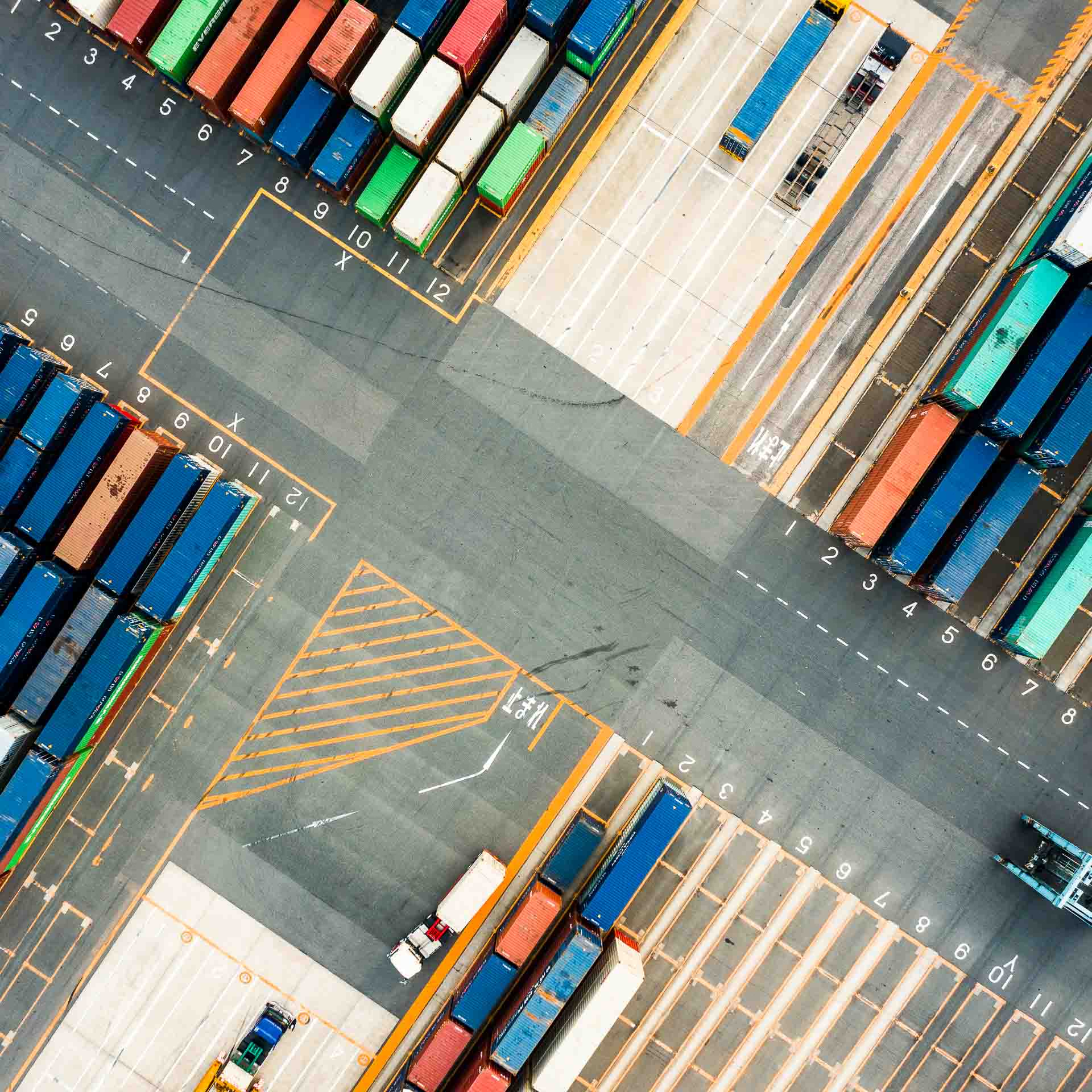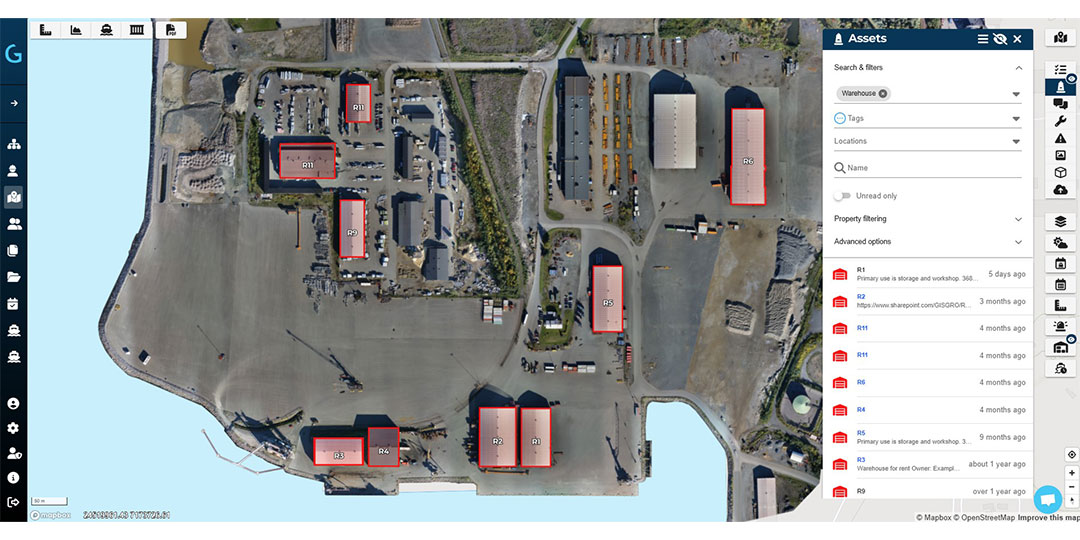Estates intelligence for ports: Turning maps into high-performance portfolios
Estates intelligence for ports
Estates intelligence connects land, infrastructure, and contracts into one visual system giving ports the control to manage assets, revenues, and sustainability with data-driven precision.

Ports today face a dual challenge: the need for greater transparency and control of their land and infrastructure – and the ability to make faster, data-driven decisions.
Estates intelligence means linking land, infrastructure, and contracts through geospatial data. It creates the operational nervous system between asset condition, usage, revenues, and ESG metrics – giving property owners, landlords and port authorities the visibility needed to manage risk, revenue, and investment planning in one unified system.
What estates intelligence means in practice?
Single Source of Truth: All plots, buildings, quays, rail, roads, utilities are georeferenced, linked with contracts and usage, visually accessible.
Lifecycle Control: Asset conditions, BIM data, inspections, maintenance, CapEx planning are extended to OPS/energy meters and ESG metrics.
Operations & Commercial: Spatially linked revenues, service workflows, KPIs. All in one system.
Why now? Five key drivers for smarter estate management
ESG and investment pressure
Europe’s ports need around €80 billion in funding by 2034 to support energy transition, digitalisation, and climate adaptation projects. Reliable estate data will be critical for securing and justifying these investments.
OPS and decarbonisation requirements
From 2030, passenger and container vessels in AFIR ports must use onshore power supply (OPS) or equivalent zero-emission solutions. From 2035, OPS becomes mandatory wherever it’s available. Ports must be able to track power availability, infrastructure readiness, and berth-level energy use.
New inland requirements
Inland ports on the TEN-T network are required to provide at least one OPS connection – core ports by 2025 and comprehensive ports by 2030, as set out in the Alternative Fuels Infrastructure Regulation. This puts pressure on infrastructure upgrades, but also on data accuracy and asset planning.
Cyber resilience regulations
Under the EU’s NIS2 Directive, port authorities must meet stricter requirements for operational technology (OT) security, partner governance, and incident reporting. This requires a structured, auditable system for managing infrastructure and suppliers.
Climate and operational risks
Seaports are already dealing with storm surges, grid stress from OPS, and high temperatures affecting infrastructure. Inland transport (waterways) is further hampered by critically low Rhine River water levels, restricting barge movements, while rail closures and construction projects are causing additional bottlenecks. Inland ports are more affected by low-water events on rivers like the Rhine and Danube, which reduce capacity and disrupt freight volumes.
A clearer picture of land and marine infrastructure, lease agreements, and risk exposure helps ports adapt to these pressures faster and more effectively.
What estates intelligence means in practice
A modern PMIS like GISGRO enables estates intelligence through the following capabilities:
A single source of truth for port assets: All plots, buildings, quays, rail, utilities and roads are georeferenced, linked with contracts, and visually accessible in one system.
Lifecycle control from inspections to CapEx: Track condition data, maintenance records, and BIM information to prioritise upgrades and monitor infrastructure readiness.
Commercial and operational alignment: Lease agreements, service requests, and invoices are spatially linked to locations, making financial and operational performance visible and auditable.
ESG visibility: Ports can link assets to energy meters, emission metrics, or sustainability KPIs, making reporting easier and decision-making more informed.
This isn’t just about compliance, it’s about enabling smarter operations that are ready for the future of port logistics.

How GISGRO supports estates intelligence
GISGRO is designed to provide the technical foundation for estates intelligence through:
- A visual digital twin of your port’s land and marine infrastructure
- Location-based workflows from inspections to invoicing
- Open integrations with ERP, sensors, or third-party tools
- Audit-ready documentation aligned with regulatory frameworks
By bringing all infrastructure data into one system, GISGRO helps ports make more confident decisions about assets, investments, and operations.
Let’s talk
If you’re looking to move from fragmented asset data to a high-performance, audit-ready systems, GISGRO can help. Book a short demo and see how estates intelligence works in practice.
Book A Demo
How Gisgro helps your work
At Gisgro, we know that each role within a port comes with its own unique challenges and requirements. Discover how Gisgro can enhance your work by exploring benefits it provides for your role—transforming complex port data into clear, actionable insights that empower you to take full control.
CEO
Harbor and Marine Operators
Land operations / Technical
Commercial
Services
GIS / CAD
IT
Finance & Accounting
View all user groups
Real people. Real support.
Whether you’re curious about how GISGRO could work for your port or you’re ready to take the next step, we’d love to hear from you. Our team is friendly, experienced, and happy to help.
Just fill out the form and we’ll get back to you soon.